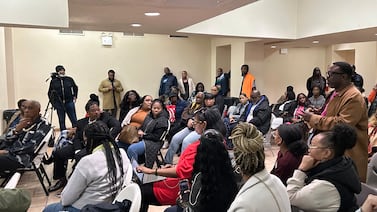Sign up for Chalkbeat Chicago’s free daily newsletter to keep up with the latest education news.
Chicago Public Schools won’t guarantee busing for general education students next school year, but officials are trying two new strategies to help more kids get to school.
Those strategies, officials said Thursday, include plans to adjust bell times at 36 district schools and piloting a program where buses pick students up at “hubs,” officials said.
The efforts are meant to help free up more buses to serve more students after the district cut service last year for about 5,500 general education students who were largely attending selective enrollment and magnet schools.
The district’s decision resulted in a constant drumbeat of criticism over the last school year from families who had lost busing. The policy even led some families to transfer out of their school.
CPS officials cited a bus driver shortage when it decided to only bus students with disabilities and those who are homeless, groups entitled to transportation under federal law. But CPS had been working to comply with a state corrective action plan imposed in 2022 that called for shorter bus rides for students with disabilities. The state closed that corrective action plan in April.
The district’s bus vendors transported just over 9,300 students last school year, with most of them students with disabilities. Another 3,600 students received a stipend to cover transportation costs. The district budgeted $146.3 million for student transportation last fiscal year, which ended on July 1, according to budget records.
CPS announced Thursday it will still offer stipends of up to $500 to students with disabilities who are eligible for transportation, but will now limit these to students who live at least five miles away from their schools. Officials said they made the change to save money and get more of these students on bus routes.
Charles Mayfield, the district’s chief operating officer, said the district is forecasting to enroll more students with disabilities next school year, which starts Aug. 26. CPS said the district intends to provide bus routes to all students with disabilities whose Individualized Education Programs, or IEPs, or 504 plans call for busing, as well as students who are homeless who qualify for busing before launching the new efforts for general education students.
Last year, about 1,900 general education students who were previously eligible for busing also received Ventra cards upon request.
The bell time adjustments will allow bus vendors to cover more routes and increase the number of students they carry, according to CPS. For example, a bus could drop off kids at a school where the start time is 7:30 a.m., then pick up and drop off students to a school that starts at 8:45 a.m., a district official told the board.
The timeline for the “hub stop” pilot program was less certain. Officials said they hope to launch it during the first quarter of the school year. Under the model, students would get on buses to their school from another school. It was unclear how close these hubs would be to students’ homes.
Once the hub pilot program starts, students in “underserved communities” will be given initial access to the hubs, officials said.
It is “the district’s goal” to provide access to the hub stops to “all general education students who are eligible,” said Mary Ann Fergus, CPS spokesperson, in a statement.
Natasha Haque, a leader in the CPS Parents for Buses group, said parents are thrilled that the district will at least try to provide rides for general education students though families still face uncertainty weeks before the school year’s start. The group, which formed last year to advocate for more transportation options, had pushed for the idea of hubs as a way to make school bus routes more efficient.
“This is a vastly different message from CPS,” Haque said. “They are trying to fill all those empty seats on school buses, which they refused to do last year.”
Haque’s husband drove their sixth grade daughter from their Lincoln Park home to her gifted program on the South Side last school year, picking up another student bound for the same school on the way and logging as much as three-and-a-half hours on that commute every day. The husband, who works multiple jobs, had to adjust his work schedule to make the trips possible.
This fall, Haque’s daughter will start seventh grade on a campus much closer to their home, largely because of how tough commuting to school was on the family.
“It was a real struggle last year, with families taking many different modes of transportation,” she said.
Over the course of last year, the district said it held multiple hiring fairs and increased driver pay to attract more drivers, but saw little movement with those efforts.
“It is too early to say how one strategy, such as adjusting bell times or establishing the hub stops, will increase student bus riders as it is contingent on other factors, including the hiring of sufficient drivers,” said Fergus in a statement.
Mila Koumpilova contributed.
Reema Amin is a reporter covering Chicago Public Schools. Contact Reema at ramin@chalkbeat.org.






